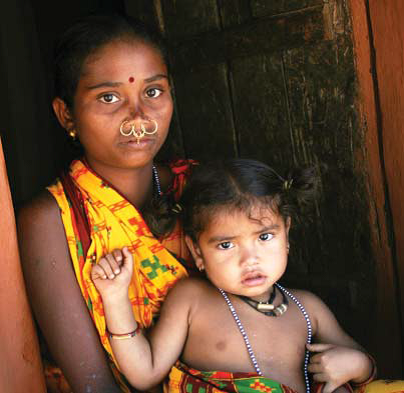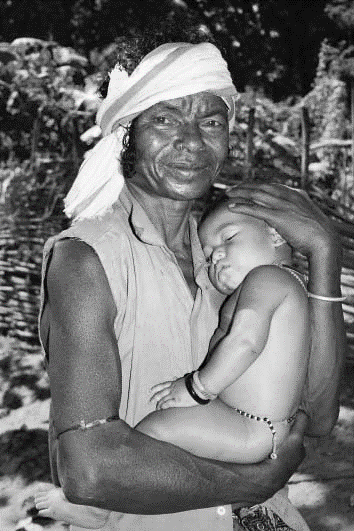Arrival of a New Child

Paraja tribe, made famous by the Jnanapitha awardee author, Sri Gopinath Mohanty in his classic “Paraja,” follows its age old traditional rituals from the stage of conception to post child birth, explains Dr. Swarnalata Sahoo
To a Paraja couple, birth of a child means arrival of a deceased ancestor. The occasion brings much joy and celebration as Paraja tribe, like most other Indian indigenous tribes, meticulously follow the tradition of ancestor worship, besides practicing an admixture of shamanism, animism and nature worship with later stage addition of few mainstream Hindu community rituals.
Spread over the hills and plains of Koraput, Malkangiri, Rayagada and Kalahandi districts of Odisha, Paraja community follows own distinct socio-religious-cultural traditions as is evident with many other indigenous tribes.
Right from the time of conception to the day of final purificatory rituals, an expecting pregnant woman has to follow a series of disciplines and restrictions in her diet, movements and daily activities to ensure wellbeing and safe delivery. Even while following the regime, may be because of their cultural habits and economic necessity, Paraja woman remain engaged in attending to their daily chores until advanced stage of pregnancy.
From the moment she informs her husband that she has conceived, she has to observe certain disciplines. She is not allowed to eat non vegetarian food and onions. She avoid looking at lunar eclipses as the tribe believes it could affect the growth of the child in her womb. She confines herself and avoids coming outside during storm, thunder and lightning. She is prohibited to touch any dead body. She would not raise her voice and shout in alarm, otherwise the child might carry forward the fear of the same. She must not sit over a pillow or on the doorway because it is believed it could lead to difficult delivery. She must not break charcoal because the child would carry black spot all over the body. Her husband will cease to cohabit with her after four months of pregnancy.
Paraja family is traditionally patrilineal and patriarchal. The tribe has a number of totemic sects named after animals and birds such as Kachim (tortoise), Bokda (Goat), Godhi (Lizard), Pandki (Dove), Bagh (tiger) Netam (Dog) etc. Out of respect they never bring harm to these animals and birds.
According to their belief, if in a pregnant mother the fetus is on the right side of the womb, it is a male child. Because they hold that a male child fears being burdened with the pitcher his mother carries on her left hip. When the fetus is on the left side of the womb, it would be a female child as according to their belief a female child is in fear of being burdened with the spade and axe that are carried on the right shoulder.
Adult monogamous marriage is the norm. They consider marriage arranged through negotiation (kudianala) as ideal and prestigious. It is common practice. Other modes of marriages such as by capture (jhikanata), by service (gharaon), by mutual consent (manaraje), by elopement (udilia) and by exchange (badulu) etc. are also seen within the community. Cross cousin marriage is a preferential mode of marriage in which a man may claim traditionally to marry with the daughter of his mother’s brother or the daughter of his father’s sister. A man can marry the widow of his deceased elder brother (boudeurghar) or deceased wife’s younger sister (tada). Remarriage of widows, widowers and divorcees are permitted in their society.
Child birth takes place in a secluded enclosure in attendance of elderly experienced women and traditional midwives. The female priest (Gurumain), who is endowed to worship the village goddess and performs rituals on festivals and for the recovery of ailing person, conducts certain rituals for smooth delivery. In case of delivery complications, witch-doctor (gunia) is approached for herbal remedies.
 Paraja tribe’s supreme deity is ‘Patrabuda’ and his consort ‘Jakar.’ The earth goddess is installed under the shed of trees at the outskirts of the village and is revered as the deity of agriculture. Their village deity Nissan munda (Hundi Devta) is seated in the centre of the village and is worshipped by the traditional priest Jani. She is propitiated during all the rituals and festivals to protect the village from calamities. The community revers deities of nature residing in hills, forests, streams and rivers such as Dongar devta (hillgod), Janikudi, Khandual etc. Their magico-religious functionaries are Jani- the priest, Disary- the astrologer, Gurumai- the female shaman and Chalan- the messenger.
Paraja tribe’s supreme deity is ‘Patrabuda’ and his consort ‘Jakar.’ The earth goddess is installed under the shed of trees at the outskirts of the village and is revered as the deity of agriculture. Their village deity Nissan munda (Hundi Devta) is seated in the centre of the village and is worshipped by the traditional priest Jani. She is propitiated during all the rituals and festivals to protect the village from calamities. The community revers deities of nature residing in hills, forests, streams and rivers such as Dongar devta (hillgod), Janikudi, Khandual etc. Their magico-religious functionaries are Jani- the priest, Disary- the astrologer, Gurumai- the female shaman and Chalan- the messenger.
A Paraja village maintains its own sit of traditional village functionaries. ‘Jani’ is the sacred custodian of the religions and moral life of the village community. ‘Muduli’ is the secular head of the village who is assisted by ‘Challan.’ Disari, Gurumai, Gunia and Bhatta Nayak are other important functionaries. Berna Munda is the place comprising stone slabs where the village headman and leaders sit to discuss village affairs.
Paraja belief is if a child is born on the night of the new moon, s/he will turn out to be a notorious thief. If the umbilical cord is twisted round the neck of the baby, it portends the death of the father, or the maternal uncle. This calamity is warded off by the father or the maternal uncle when he kills a fowl and wears its entrails round the neck and, subsequently, burying it along with the umbilical cord.
Post child birth, the mid-wife cuts the umbilical cord which is buried in a hole in the backyard or in the place where rain water falls from the roof. The child is given a bath in lukewarm water in the courtyard. Pollution period for the mother and the child continues until the time the naval cord is dried completely which is usually up to 16 days after birth. There are three important rituals associated within one month from the birth of a child. These rituals are called Nahihandisara, Sanahandisara and Ekosia.
Nahihandisura ritual is performed on the day when the naval cord falls. This ritual is done to purify the mother and the family members from birth pollution. The mid-wife wraps the naval cord with palm leaves and throws it into the pit dug for this purpose in the backyard which is later filled with earth. A lamp is lit and incense sticks are lighted near the pit to ward off evil spirits. Post this ritual, the mother and child take bath and change their clothes. On that day, all clothes and utensils are washed, the house is cleaned and plastered with cow dung. Turmeric and tulsi water is sprinkled all over the house with the help of mango leaves. Family deities are worshipped for the well-being of the family as well as the new born. Pots, clothes and mat used in the delivery room are removed from the house. Then, the mother washes the feet of the mid-wife with turmeric water and oil. The mid-wife is offered new cloth, some amount of rice, ragi, turmeric, oil and vegetables.
Sanahadisara is observed soon after the stoppage of the menstrual flow of the mother that stops within 12 to 15 days after the child birth. Before this ritual, the mother is considered impure and is not permitted to touch any family members in the house. She does not cook for anyone. During this period, her husband prepares food for him and her, which is not shared with any other family member. On that day, she discards and throws away all used earthen pots replacing these with new ones. She washes all of her clothes, takes bath by washing her hair. She worships the family deity seeking blessings for herself and for her child. Post this ritual, she gets back to all her normal activities. Unlike Nahihandisura ritual where the mid-wife takes centre stage, in this ritual the mother does everything for overcoming the stage of pollution.
Ekosia is the ritual done on the 21st day of child birth which includes the first hair cutting and name giving ceremony. However, this ceremony gets delayed sometimes due to financial inconvenience or for some other reasons. Maternal uncle and grandparents take lead on this occasion. They present a dress to the new born baby, and clothes to the child’s parents. They bring one towel and six numbers of brass plates and cups. The mother applies milk on the head of the child. The traditional astrologer (Disari) cuts the hair of the child, collects that in a leaf cup. The mother of the baby takes that cup to a stream and offers that to the stream wishing long life to the child. After this, both the mother and the child take bath and wear new clothes. Disari, the village astrologer forecast about the future of the child.
On that particular day, child naming is also done. Here, it is important to know about the mason (ancestor) who brought this child. By keeping the child on the lap and holding a brass plate, the maternal uncle sits on the courtyard where all the family members gather. The Disari takes turmeric water in a leaf cup. Then he takes seven grains of rice and drops it into the turmeric water by uttering the name of family ancestors one after another. If a grain of rice starts floating while uttering a particular name, it is believed that the child has come from that ancestor. Family members present there wash the feet of the child with milk and drop money on the brass plate held by the maternal uncle. That day, the family of the child offer a feast prepared on a new heart